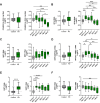Peripheral monocyte transcriptional signatures of inflammation and oxidative stress in Parkinson's disease
- PMID: 40771809
- PMCID: PMC12325044
- DOI: 10.3389/fimmu.2025.1571074
Peripheral monocyte transcriptional signatures of inflammation and oxidative stress in Parkinson's disease
Abstract
Parkinson's disease (PD) is a progressive neurodegenerative disorder characterized by dopaminergic neuron loss in the substantia nigra, which is accompanied by immune dysfunction and chronic inflammation. Peripheral monocytes, key players in systemic inflammation, cross the blood-brain barrier and alter PD etiology and progression. To define the role of peripheral monocytes, cross-sectional studies of RNA transcripts isolated from PD monocytes were compared with age- and sex-matched control monocytes. After stratification by Hoehn & Yahr (H&Y) stage, inflammatory transcripts IL-6, IL-1β, ARG1, CD163, and CCR2 were upregulated in PD monocytes and increased with disease burden. Furthermore, PPARGC1A (PGC-1α), GPX4, NFE2L2 (NRF2), and SIRT3 decreased with increasing disease burden, while only SIRT1 expression increased, reflecting oxidative stress and mitochondrial dysregulation. Overall, the PD monocyte transcripts correlated with PD disease burden as monitored by H&Y, UPDRS total, UPDRS Part 3, ADL, and disease duration. This study demonstrated that dysregulation of inflammation and oxidative stress pathways contributed to disease progression in PD. Monocytes may serve as biomarkers for tracking clinical symptoms and could be leveraged as targets for therapeutic intervention.
Keywords: Parkinson’s disease; inflammation; monocytes; neurodegeneration; neuroimmunology; neuroinflammation; oxidative stress; peripheral biomarkers.
Copyright © 2025 Thome, Wang, Atassi, Thonhoff, Faridar, Zhao, Beers, Lai and Appel.
Conflict of interest statement
AT is a consultant for Coya Therapeutics, Inc. JT transitioned employment from Houston Methodist to Director of Clinical Development at Coya Therapeutics, Inc. during preparation of the manuscript. AF is a consultant for Coya Therapeutics, Inc. SHA is Chair of the Coya Scientific Advisory Committee. Coya Therapeutics, Inc. has licensed research from Houston Methodist Research Institute. The remaining authors declare that the research was conducted in the absence of any commercial or financial relationships that could be construed as a potential conflict of interest.
Figures



References
MeSH terms
Substances
LinkOut - more resources
Full Text Sources
Medical
Research Materials
Miscellaneous

